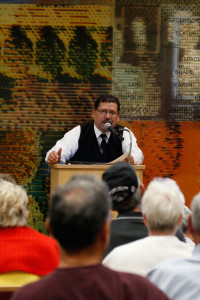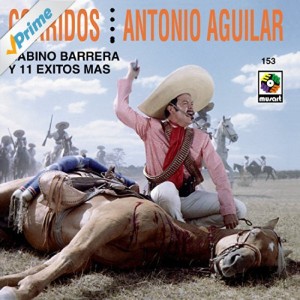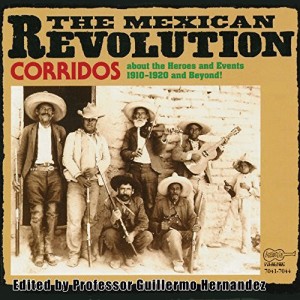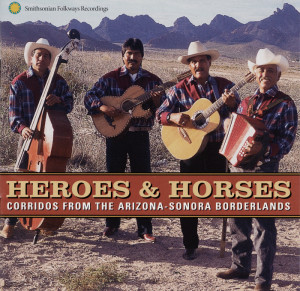I’m trying to learn the lyrics to some of these. I love the melodies, especially of the first song.
Tag Archives: corridos
Una Noche De Corridos / Program (2013)

This was the first in a series of 3 corridos programs held between 2013 and 2016. Several performers shared their talents, including Mr. Bobby Benton, Mr. Jim Griffith, Justin Enriquez and Juan Aguilar of Los Cuatro Vientos, and an unknown gentlemen who shared some of his own original compositions. It was a night to remember. See below to listen to the audio of the program.
Many thanks to Aengus Anderson for shooting this beautiful promotional video for Una Noche De Corridos, featuring Justin Enriquez and Juan Aguilar.
From the UA News Service:
“Celebrate Hispanic Heritage Month at the UA Special Collections as local musicians, including UA students, perform ballads of passion, pride and politics, also known as corridos. Throughout the oral history and tradition of Mexico, the corrido has been a source of information, education and celebration about events, people or places.
The corrido was particularly important during the Mexican War of Independence and the Mexican Revolution when news of events, heroes and tragedies were shared through the genre.
Often times sung by a single performer playing a guitar, corridos vary in length, style and rhythm. As a staple of Mexican musical life, corridos are also celebrated in an annual contest held during the Tucson Meet Yourself festival”.
Watch the entire program here:


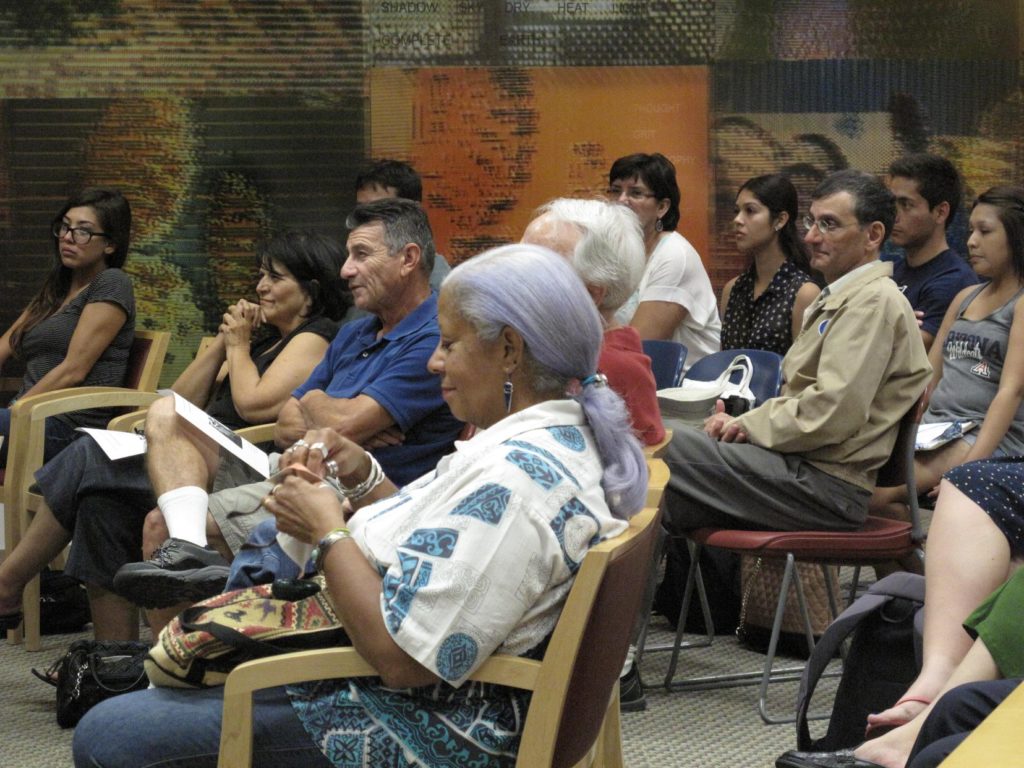
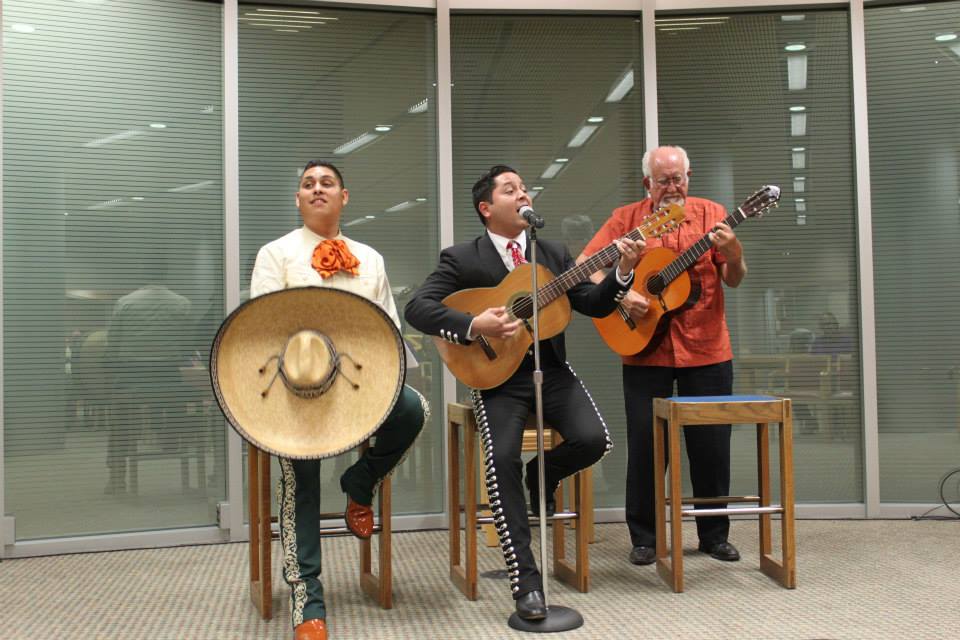


UNA NOCHE DE CORRIDOS /Program (2016)
“Special Collections hosts its third annual evening of song, featuring local musicians performing Mexican corridos in Spanish. Similar to English ballads, corridos tell the story of an event, a person or a place, and often include words of wisdom for those tempted by lust or greed. A brief lecture, titled, “An Introduction to the Corrido” will be given by Bob Diaz, Special Collections curator for the performing arts. This program is supported by the Mexican American Studies department”.
Listen to the audio of the program here.
Wow, what can I say? I’m so glad that “Una Noche de Corridos” event turned out so well, in spite of the fact that the musicians that agreed to play for us were not able to make it after all. We had over 100 people in attendance. I had asked the musicians to show up 15 minutes early. By 6pm, they still hadn’t shown up. I was sweating bullets by then.
When 6pm rolled around it was time to start the program. I gave my presentation on the corrido, and fumbled a bit along the way with having to toggle back and forth from one program to another, but I got through it. The audience was very receptive and understanding, and they seemed to enjoy the videos I presented.
Once I ended my part of the program (see my previous blog post, What’s to know about corridos, anyway?, as I used it as the basis for the presentation), it was time to announce that our expected musicians hadn’t shown up. I then asked if there were any other musicians in the house who wanted to sing. I knew Bobby Benton was there with his guitar, so I figured I could count on him. He agreed to sing. And lo and behold, to everyone’s delight and surprise another individual also came forward. Her name is Tiffany Alvarez. I had my guitar on hand, so she used it to perform. Tiffany is a biologist and mariachi musician who has performed with Mariachi Mujer 2000, and Bobby Benton is a native of Barrio Anita, and a well respected singer whose talents can be heard on the cd recording titled Heroes and Horses: Corridos from the Arizona-Sonoran Borderlands.
 They each sang three songs, and accompanied one another on guitar. The songs included: El Siete Leguas, La Herradera, El Corrido de Nogales, and El Preso Numero Nueve. The audience just ate it up. They loved it!
They each sang three songs, and accompanied one another on guitar. The songs included: El Siete Leguas, La Herradera, El Corrido de Nogales, and El Preso Numero Nueve. The audience just ate it up. They loved it!
Again, I can’t say how grateful I am to these two wonderful individuals!
After the program, folks stuck around to enjoy some food and beverages. I met many wonderful people last night. My good friends Mima and Pernela were there too. We sang happy birthday to Mima, and I mentioned that Pernela had won a corrido contest at Tucson Meet Yourself. She said she was going to get me back for that one. She brought her sister Gloria, who used to babysit me when I was a baby. I love Gloria. She reminds me of Mrs Jones. She and Irene, my sister, were great friends in their youth.
By the time I got home last night, it was nearly 9pm. I was exhausted, and still a bit in shock over what happened. Thank goodness it all turned out so well!
Here is a very nice note I just received from someone who attended:
Hello Bob:
Just a quick note to say how much my son and I enjoyed last night’s program! We had a great time.
I really enjoyed the musicians and the snacks after. The whole thing reminded me of when I was a kid and my dad and uncles would sit in the backyard on a Saturday night playing the guitar and singing, all while the beer and tequila flowed. Of course, my mother wasn’t happy about the last part but I remember when my grandmother would join in the singing. I haven’t thought about that for a long time, so thank you.
Anyway, I wanted you to know that it was a lot of fun. And we enjoyed your talk, too. My dad used to play all kinds of Jose Jimenez records.
Karen
————————————-
P.S.
Writer Xavier Omar Otero wrote this review of the event for the Tucson Weekly.

WHAT’S TO KNOW ABOUT CORRIDOS ANYWAY?
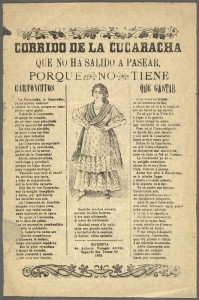 (click on the graphic to get a larger image)
(click on the graphic to get a larger image)
“The corrido is a Mexican folk ballad that stems from the romance español, a long, often epic ballad introduced by the Spanish colonizers. It’s transformation into a distinct Mexican form occurred during Mexico’s struggle for independence in the early nineteenth century”. –Helena Simonett, in BANDA: MEXICAN MUSICAL LIFE ACROSS BORDERS
There is one answer for you. Other writers note that the corrido is derived from a combination of Spanish song styles, not just the romance. Corridos were quite popular during the Mexican American War and reached even greater heights of popularity during the Mexican Revolution. A typical corridista would stand on street corners and sing to the passersby, often distributing the songs on “hojas” or leaves of large pieces of colored paper (referred to in English as broadsides). While some scholars such as Vicente Mendoza argue that the true form died out after the Revolution, others stress that the corrido has merely evolved, and that it flourishes to this day.
Corridos can be written about any number of topics. Some of the more popular corridos are about the Mexican Revolution, its heroes and villains, and the great battles that were fought. Others are about places, or about people who get themselves into trouble for being too bold or stubborn. There are also corridos about horses, cock fighting, and drug running. The latter are called narcocorridos, and they are extremely popular today.
 According to the Mexican scholar Vicente Mendoza, a typical corrido usually contains some of the following elements: the initial call of the corridista or the balladeer to the public, sometimes called the formal opening; the stating of the place, date and name of the protagonist of the ballad; the arguments of the protagonist; the message; the farewell of the protagonist; and the farewell of the corridista. (Mendoza, Vicente. La Lirirca Narrativa de Mexico, pp17-18, 1964). Of course, not all corridos follow this formula to the letter, but most corridos do include a closing or farewell message of one kind or another.
According to the Mexican scholar Vicente Mendoza, a typical corrido usually contains some of the following elements: the initial call of the corridista or the balladeer to the public, sometimes called the formal opening; the stating of the place, date and name of the protagonist of the ballad; the arguments of the protagonist; the message; the farewell of the protagonist; and the farewell of the corridista. (Mendoza, Vicente. La Lirirca Narrativa de Mexico, pp17-18, 1964). Of course, not all corridos follow this formula to the letter, but most corridos do include a closing or farewell message of one kind or another.
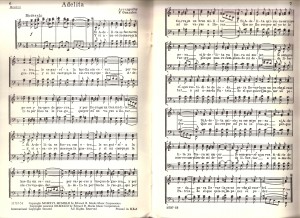 La Adelita (Click on graphic to enlarge)
La Adelita (Click on graphic to enlarge)
Simonett states that, “the corrido is usually sung in 2/4 or 3/4 time, and that its harmony is based on the tonic, dominant and subdominant chords. It is usually constructed of a number of stanzas of four or six octosyllabic lines, and the melodic phrases are repeated for each stanza. Occasionally, the corrido has a melodic refrain, which may be in a different rhythm”. (Simonett, Helena. Banda: Mexican Musical Life Across Borders, 2001).
I grew up listening to El Corrido del Caballo Blanco from the time I was 2. The song opens with the sound of a galloping horse. Anyone who hears that sound who is familiar with Mexican music, recognizes it almost immediately as being the opening to one of Jose Alfredo’s most popular songs.
When I was in my early teens, our local drugstore, El Campo Drugs on the corner of 22nd and Country Club, had a record bin with Mexican albums. One day I asked my mom to buy me one. She liked Mexican music a lot, so it wasn’t hard to convince her. I chose Antonio Aguilar’s album, Corridos. It included some of the most famous corridos ever written, such as Gabino Barrera, Juan Charrasqueado, El Hijo Desobediente, and Rosita Alvirez.
In high school, I learned more about Mexican popular music in a class called “Cultural Awareness”, one of the very first Chicano Studies classes (1974) ever offered in Tucson. Our teachers brought record albums to the classroom that included corridos of the Mexican Revolution. Songs like La Adelita and Valentin de La Sierra (see Ana Gabriel’s version below) resonated with me. They alluded to a history I was not yet familiar with, but was closer to me than I realized. My own grandparents had immigrated to the U.S. both during and after the Mexican Revolution. Their lives were directly impacted by this conflict. It took me a while to realize what this really meant to me.
I began to slowly collect record albums in high school, although I didn’t have a strong interest in Mexican music until after I graduated from college and joined KXCI radio in 1983 as a volunteer disc jockey. At that point, I started hosting two radio shows. One was a three hour morning program, and the other was a specialty program called The Chicano Connection. My goal in doing this was to present both American and Latin music to the public. Once I started listening to and collecting more music in Spanish, particularly Mexican folk music, I started to become more familiar and comfortable with the corrido repertoire, and I began to collect songbooks, albums and whatever else I could find. One artist, whose song Doña Elena y El Francés, was one of my uncle’s favorites, was the great actor Ignacio Lopez Tarso. He issued two albums of corridos of the Mexican Revolution. They are comprised of spoken word monologues accompanied by music. Here’s an example.
I have discovered over time that there are a variety of types of recordings of corridos. Some would argue that the only ones that are “authentic” and worth listening to are those that were recorded in the early part of the 20th century, or “in the field” so to speak, by folklorists. These are performed generally by working musicians, who may or may not possess the best voices. They appeal to me on a different level than those recordings that are considered more commercial, and which are quite frankly more readily accessible to the general public. (Below, however, is one set of recordings that were made in the early 20th century that is readily available from Arhoolie Records).
Another recording, one that has the feel of a field recording, but was actually recorded in 2002 , is titled, Heroes and Horses: Corridos from the Arizona Sonora Borderlands. It is also readily available from Smithsonian Folkways. It was compiled by James Griffith, folklorist and co-founder of Tucson Meet Yourself.
Some of Mexico’s greatest ranchera singers, including Miguel Aceves Mejia, Lola Beltran, Lucha Villa and Antonio Aguilar, have helped preserve the corrido by recording them on their albums. Aguilar, for example, has issued several corrido albums, including one about the Mexican Revolution and another one all about horses.
Here’s one more corrido, this time by Lucha Villa. It’s called El Hijo Desobediente.
One of my all time favorite albums of corridos is Amparo Ochoa’s recording, Corridos y Canciones de la Revolucion Mexicana, which was issued in 1983. It includes definitive versions of La Adelita, El Soldado, and Valentin de la Sierra. It also includes a very moving song called La Caritina, written by Victor Cordero, a contemporary composer. The song is about a female revolutionary colonel who fought alongside Pancho Villa, but who was not officially recognized by the Mexican government, and who ends up dying in abject poverty. Here’s Amparo Ochoa singing this song live.
Since the 1970s, narcocorridos have been very popular with the Mexican public. A wildly popular group called Los Tigres Del Norte are largely responsible for popularizing this type of corrido. Other artists such as Chalino Sanchez helped further the form’s popularity.
Corridos continue to be written to this day. Many are political or deal with current events and contemporary issues. Below is an example of a relatively new corrido about President Obama. It was recorded in 2008 by Los Dorados Del Norte. Youtube is a great source for finding these songs. There even exist corridos about Hillary Clinton and Donald Trump, some of which are very biting and funny. I’ll leave it to you the reader to explore these on your own. Have fun!
Locally, corridos are very popular in Southern Arizona. Back in the 1980s, a local group called Mariachi America, led by Gilbert Velez, recorded “El Corrido de Tucson”. Tucson Meet Yourself has also held corrido contests for many years, and the University of Arizona Poetry Center has sponsored a number of contests for high school students. Below is an example of such a corrido, written and sung by Araceli Valenzuela. The corrido won the 2010 Bilingual Corrido contest. Alfredo Valenzuela is a local teacher, now retired, who created the youth mariachi program at Davis Elementary School.
Below is a list of books you can read to learn more about the corrido. Those available online are linked to Amazon. Local libraries such as the University of Arizona Library, Pima Community College LIbrary, and the Pima County Public LIbrary also have some materials.
- Chew Sanchez, Martha I. Corridos in migrant memory. Albuquerque: University of New Mexico Press, 2006.
- Dickey, Dan William. The Kennedy Corridos: A Study of the Ballads of a Mexican American Hero. Austin: The University of Austin Center for Mexican American Studies, 1978.
- Herrera-Sobek, Maria. The Mexican corrido: a feminist analysis. Bloomington: University of Indiana Press, 1990.
- Mendoza, Vicente T. El Corrido Mexicano. Mexico: Fondo de Cultura Economica, 1954 (2004).
- Paredes, Americo. With his pistol in his hand: a border ballad and its hero. Austin: University of Texas Press, 1958.
- Wald, Elijah. Narcocorrido: a journey into the music of drugs, guns, and guerrillas. New York: Harper Collins, 2001.
Here are a few corrido recordings that are available for sale online via Amazon.
- The Mexican Revolution: Corridos. These recordings are from the early 20th century. They are considered some of the most authentic corrido recordings available.
- Antonio Aguilar: Corridos Famoso, 15 Exitos
- Miguel Aceves Mejia: Corridos y Caballos Famosos
- Los Hermanos Zaizar: Cantares de la Revolucion
- Lucha Villa: Sus Grandes Corridos
- Heroes and Horses: Corridos from the Arizona Sonora Borderlands

